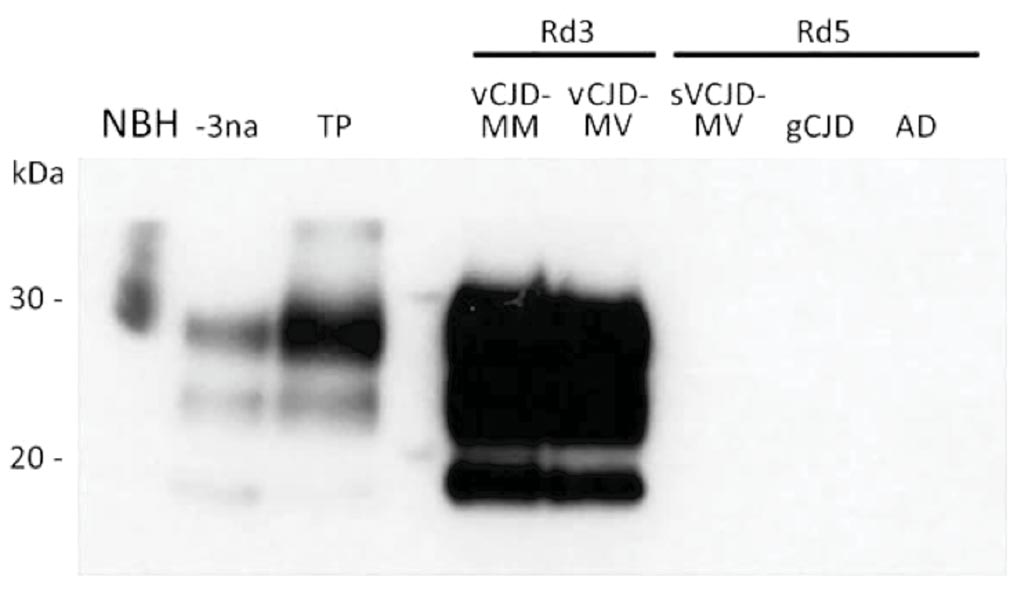Variant CJD Diagnosed by Protein Misfolding Amplification
By LabMedica International staff writers
Posted on 06 Jul 2018
Variant Creutzfeldt-Jakob disease (vCJD) is a neurodegenerative infectious disease caused by transmission of a cattle prion disease (bovine spongiform encephalopathy) to humans. Most vCJD cases have occurred in the United Kingdom, where an estimated 1 in 2,000 persons is potentially asymptomatically infected.Posted on 06 Jul 2018
A diagnostic test to identify methionine/valine heterozygous vCJD cases is urgently needed to enable discrimination between heterozygous vCJD and sporadic CJD (sCJD) and in view of the potential reservoir of methionine/valine heterozygous asymptomatic vCJD carriers in the blood donor population.

Image: A Western blot analysis of vCJD prions obtained after amplification by protein misfolding cyclic amplification (PMCA) of cerebrospinal fluid (CSF) from two patients with vCJD (MM and MV) and three control patients and a crude reference brain homogenate from a vCJD patient (Photo courtesy of Etablissement Français du Sang).
Scientists at the Etablissement Français du Sang (Montpellier, France) and their colleagues analyzed 98 cerebral spinal fluid (CSF) samples after obtaining appropriate consent. Clinicians distributed CSF samples into blinded panels from the United Kingdom and France; 41 from patients with vCJD; 23 from patients with sCJD; one from a patient with genetic CJD; and 33 from patients with non-CJD, including samples from patients with Alzheimer’s disease and patients with non-neurodegenerative diseases.
The team performed protein misfolding cyclic amplification (PMCA) amplification by using brains from humanized transgenic mice as substrate for normal prion protein. After successive rounds of 160 cycles of PMCA for 15 minutes and sonication for 20 seconds, they detected abnormal prion protein (PrPTSE) by using Western blot after digestion with proteinase K. Of the 98 CSF samples analyzed, the assay identified 40 of 41 cases of clinical vCJD, including the methionine/valine heterozygous patient, thus showing a diagnostic sensitivity of 97.6%. One CSF sample from a probable case of vCJD showed a negative result. After decoding by clinicians, they retested this sample in duplicate and it showed a positive result.
The team then then compared by using Western blot the PrPTSE molecular signature obtained for the clinical vCJD amplified samples from classical methionine homozygous cases and the new methionine/valine heterozygous vCJD case with that of the reference brain sample from a patient with vCJD. As expected, the profile obtained after PMCA amplification of the CSF from the methionine/valine heterozygous vCJD patient was similar to those obtained for methionine homozygous vCJD patients. The characteristic type 2 mobility and clear predominance of the diglycosylated isoform was obtained for all vCJD patients before or after amplification.
The authors concluded that application of real-time quaking-induced conversion (RT-QuIC) and PMCA for CSF samples might represent a suitable strategy for premortem discrimination between sCJD and vCJD including methionine/valine heterozygous case-patients, particularly for cases with a heterozygous codon 129 genotype in which clinical distinction between sCJD and vCJD is problematic. The study was published in the July 2018 issue of the journal Emerging Infectious Diseases.
Related Links:
Etablissement Français du Sang














